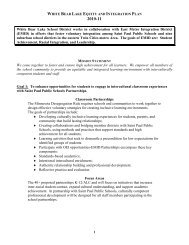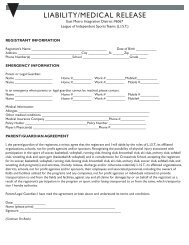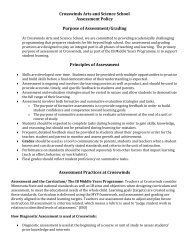Minnesota Academic Standards Language Arts K-12 - East Metro ...
Minnesota Academic Standards Language Arts K-12 - East Metro ...
Minnesota Academic Standards Language Arts K-12 - East Metro ...
You also want an ePaper? Increase the reach of your titles
YUMPU automatically turns print PDFs into web optimized ePapers that Google loves.
Grade<br />
Level<br />
GRADE<br />
9, 10, 11,<br />
<strong>12</strong><br />
Strand Sub-Strand Standard Benchmarks<br />
D. Literature The student will actively<br />
engage in the reading<br />
process and read,<br />
understand, respond to,<br />
analyze, interpret, evaluate<br />
and appreciate a wide<br />
variety of fiction, poetic and<br />
nonfiction texts.<br />
1. Read, analyze and evaluate traditional, classical and<br />
contemporary works of literary merit from American<br />
literature.<br />
2. Read, analyze and evaluate traditional, classical and<br />
contemporary works of literary merit from British literature.<br />
3. Read, analyze and evaluate traditional, classical and<br />
contemporary works of literary merit from civilizations and<br />
countries around the world.<br />
4. Evaluate the impact of an author’s decisions regarding<br />
word choice, point of view, style and literary elements.<br />
5. Analyze, interpret and evaluate the use of figurative<br />
language and imagery in fiction and nonfiction selections,<br />
including symbolism, tone, irony and satire.<br />
6. Analyze and evaluate the relationship between and among<br />
elements of literature: character, setting, plot, tone,<br />
symbolism, rising action, climax, falling action, point of<br />
view, theme and conflict/resolution.<br />
7. Evaluate a literary selection from several critical<br />
perspectives.<br />
8. Analyze classic and contemporary poems for poetic<br />
devices.<br />
9. Analyze the characteristics of literary forms.<br />
10. Interpret the effect of literary and structural devices.<br />
11. Demonstrate how literary works reflect the historical<br />
contexts that shaped them.<br />
<strong>12</strong>. Synthesize ideas and make thematic connections among<br />
literary texts, public discourse, media and other disciplines.<br />
13. Read, analyze, and critique dramatic selections by<br />
comparing and contrasting ways in which character, scene,<br />
dialogue, and staging contribute to the theme and the<br />
dramatic effect.<br />
14. Respond to literature using ideas and details from the text<br />
to support reactions and make literary connections.<br />
15. Read from and respond to a variety of fiction, poetic and<br />
nonfiction texts of increasing complexity for personal<br />
enjoyment.







